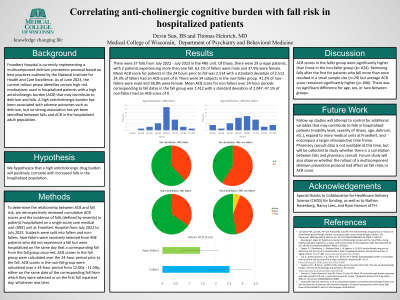Quality and Safety
(158) Correlating anti-cholinergic cognitive burden with fall risk in hospitalized patients

- DS
Devin Sun
MD Student
Medical College of Wisconsin
Wauwatosa, Wisconsin 
Thomas Heinrich, MD, FACLP (he/him/his)
Professor of Psychiatry and Family Medicine
Medical College of Wisconsin
Milwaukee, Wisconsin
Presenting Author(s)
Co-Author(s)
Disclosure(s):
Devin Sun, n/a: No financial relationships to disclose
Froedtert Hospital is currently implementing a multicomponent delirium prevention protocol based on best practices outlined by the National Institute for Health and Care Excellence. The current phase identifies certain high-risk medications used in hospitalized patients with a high anticholinergic burden (ACB) that may contribute to delirium and falls. High anticholinergic burden has been associated with adverse outcomes like delirium, but no strong association has yet been identified between falls and ACB in hospitalized adults. This study uses pilot data from Froedtert to examine any initial trends.
Methods
We retrospectively reviewed cumulative ACB scores and the incidence of falls (defined by severity) in patients hospitalized on a single acute care medical unit (4NE) unit at Froedtert Hospital from July 2022 to July 2023. Subjects were split into fallers and non-fallers. Non-fallers were randomly selected from 4NE patients who did not experience a fall but were hospitalized on the same day that a corresponding fall from the fall group occurred. ACB scores in the fall group were calculated over the 24-hour period prior to the fall. ACB scores in the non-fall group were calculated over a 24-hour period from 12:00a - 11:59p, either on the same date of the corresponding fall from which they were selected or on the first full inpatient day, whichever was later.
Results
There were 37 falls in the 1 year period. Of those, there were 29 unique patients, with 2 patients experiencing more than one fall. 62.1% of fallers were male and 37.9% were female. Mean ACB score for patients in the 24 hours prior to fall was 2.514 with a standard deviation of 2.512. 24.3% of fallers had an ACB score of 0. There were 34 subjects in the non-faller group. 41.2% of non-fallers were male and 58.8% were female. Mean ACB score for non-fallers over 24-hour periods corresponding to fall dates in the fall group was 1.412 with a standard deviation of 2.047. 47.1% of non-fallers had an ACB score of 0.
Discussion
ACB scores in the faller group were significantly higher than those in the non-faller group (p=.024). Removing falls after the first for patients who fell more than once resulted in a small sample size (n=29) but average ACB score remained significantly higher (p=.046). There was no significant difference for age, sex, or race between groups.
Implications
Preliminary analysis of pilot data shows a correlation between ACB score and fall rates during the one year period examined. Ongoing follow-up studies will expand to more medical units at Froedtert, encompass a larger retrospective time frame, and control for additional variables that may contribute to falls,
References
Carnahan RM, Lund BC, Perry PJ, Pollock BG, Culp KR. The Anticholinergic Drug Scale as a measure of drug-related anticholinergic burden: associations with serum anticholinergic activity. J Clin Pharmacol. 2006 Dec;46(12):1481-6.
Akgün, Ö., Oudshoorn, C., Mattace-Raso, F., & Egberts, A. (2022). Anticholinergic drug use on admission and the risk of In-Hospital falls in older hospitalized patients. Clinical Interventions in Aging, Volume 17, 277-285.
Presentation Eligibility: Not previously published or presented.
Diversity, Equity, and Inclusion: Froedtert Hospital serves all communities from Milwaukee and surrounding areas, and is committed to providing healthcare services that meet social, cultural, and linguistic needs of patients. The patient population in this study reflects this diversity, and its findings will be used to inform decisions that provide the best medical decisions towards individual patients regardless of their race, gender, or SES.

